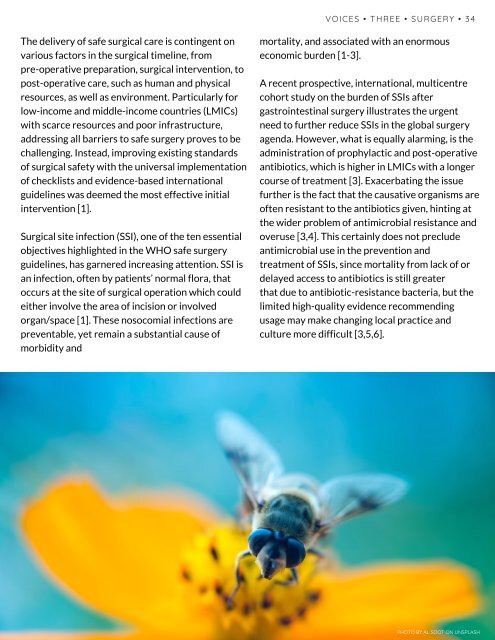Safety First - Voices of One Surgery - Issue 4: December 2018
As we celebrate 10 years of the launch of the World Health Organisation Surgical Safety Checklist and the success it gave, One.Surgery recognises the many challenges that still exist today in the pursuit of providing safe surgery to every patient worldwide.
As we celebrate 10 years of the launch of the World Health Organisation Surgical Safety Checklist and the success it gave, One.Surgery recognises the many challenges that still exist today in the pursuit of providing safe surgery to every patient worldwide.
You also want an ePaper? Increase the reach of your titles
YUMPU automatically turns print PDFs into web optimized ePapers that Google loves.
VOICES • THREE • SURGERY • 34<br />
The delivery <strong>of</strong> safe surgical care is contingent on<br />
various factors in the surgical timeline, from<br />
pre-operative preparation, surgical intervention, to<br />
post-operative care, such as human and physical<br />
resources, as well as environment. Particularly for<br />
low-income and middle-income countries (LMICs)<br />
with scarce resources and poor infrastructure,<br />
addressing all barriers to safe surgery proves to be<br />
challenging. Instead, improving existing standards<br />
<strong>of</strong> surgical safety with the universal implementation<br />
<strong>of</strong> checklists and evidence-based international<br />
guidelines was deemed the most effective initial<br />
intervention [1].<br />
Surgical site infection (SSI), one <strong>of</strong> the ten essential<br />
objectives highlighted in the WHO safe surgery<br />
guidelines, has garnered increasing attention. SSI is<br />
an infection, <strong>of</strong>ten by patients’ normal flora, that<br />
occurs at the site <strong>of</strong> surgical operation which could<br />
either involve the area <strong>of</strong> incision or involved<br />
organ/space [1]. These nosocomial infections are<br />
preventable, yet remain a substantial cause <strong>of</strong><br />
morbidity and<br />
mortality, and associated with an enormous<br />
economic burden [1-3].<br />
A recent prospective, international, multicentre<br />
cohort study on the burden <strong>of</strong> SSIs after<br />
gastrointestinal surgery illustrates the urgent<br />
need to further reduce SSIs in the global surgery<br />
agenda. However, what is equally alarming, is the<br />
administration <strong>of</strong> prophylactic and post-operative<br />
antibiotics, which is higher in LMICs with a longer<br />
course <strong>of</strong> treatment [3]. Exacerbating the issue<br />
further is the fact that the causative organisms are<br />
<strong>of</strong>ten resistant to the antibiotics given, hinting at<br />
the wider problem <strong>of</strong> antimicrobial resistance and<br />
overuse [3,4]. This certainly does not preclude<br />
antimicrobial use in the prevention and<br />
treatment <strong>of</strong> SSIs, since mortality from lack <strong>of</strong> or<br />
delayed access to antibiotics is still greater<br />
that due to antibiotic-resistance bacteria, but the<br />
limited high-quality evidence recommending<br />
usage may make changing local practice and<br />
culture more difficult [3,5,6].<br />
PHOTO BY AL SOOT ON UNSPLASH








